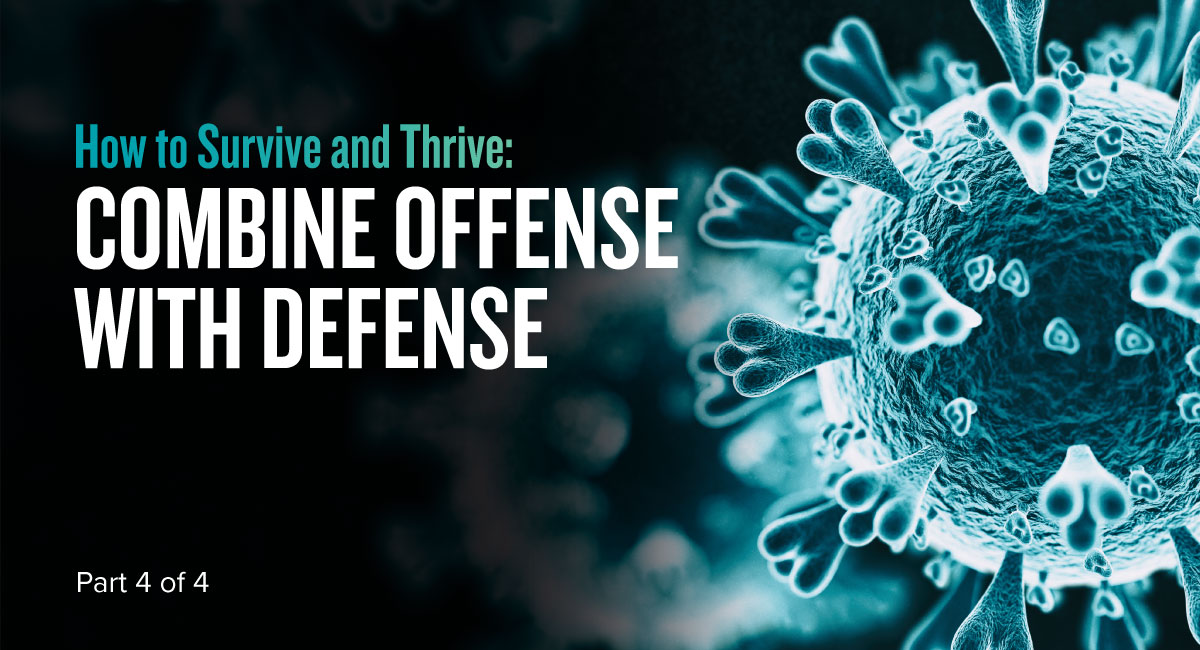This is the fourth of a four-part series describing these steps:
- Embrace humility.
- Overcome fear with action.
- Prioritize people and purpose.
- Combine offense with defense.
Free White Paper and Webinar
Download the “Coronavirus: How to Survive and Thrive” White Paper and view the webinar recording.
Download White Paper Watch Recording
Combine Offense with Defense
Despite anecdotal stories and conventional wisdom about the best way to survive and thrive in a recession, there is little empirical data available about what strategies work best.
A trio of Harvard Business School researchers spent a year studying corporate strategies and performance before, during and after three global recessions that occurred in 1980, 1990 and 2000. The study, by professors Ranjay Gulati and Nitin Nohria and doctoral student Franz Wohlgezogen, analyzed the three years before the crisis and three years following it, as well as the recession period.
Of the companies studied:
- 17% did not survive: They went bankrupt, were acquired or became private.
- 74% of the companies survived – barely, with most still not at pre-recession growth rates three years later.
- 9% of the companies thrived, outperforming their competitors in sales and profit growth.
“According to our research, companies that master the delicate balance between cutting costs to survive today and investing to grow tomorrow do well after a recession,” the trio wrote. “Within this group, a subset that deploys a specific combination of defensive and offensive moves has the highest probability – 37% – of breaking away from the pack. These companies reduce costs selectively by focusing more on operational efficiency than their rivals do, even as they invest relatively comprehensively in the future by spending on marketing, R&D and new assets.”
These investments include brand building and strengthening, targeted marketing to reach key audiences, and the creation of new products and offerings that meet and anticipate customer needs. Those companies that get it right will be the ones that stay closest to their customers and invest in the right things, while making the changes necessary to become more efficient.
A new survey of 1,000 American consumers, conducted on March 18, reveals that consumers want brands to continue to invest in marketing and communications. The survey, conducted by the 4A’s Research Service, found only 15% of those surveyed said they don’t want to hear from brands right now. Of those surveyed, 56% said they are pleased to hear about brands taking action, like donating goods and services, and 43% said it is reassuring to hear from brands they know and trust.
Among the actions that brands can take, consumers ranked offering paid time off to employees affected by closures highest. Such action is particularly important to Millennials (60.5%) and Gen Z (62.5%) consumers.
The pandemic will be a complete reset for American society and business, creating new opportunities along with challenges. Time will tell which businesses survive, but there are some early indications of which ones might.
Some examples of combining offense with defense:

Amazon AWS is investing $20 million in a new diagnostics unit that will create faster and more affordable testing capacity. While the initial focus for the effort will be Coronavirus, the initiative involves 35 global research institutions, startups and businesses. More accurate and readily available diagnostics could bring scale and efficiencies to testing across a variety of diseases and improve treatment and containment of Coronavirus. It also could create an entirely new revenue stream for Amazon AWS.
As millions of students and employees turn to the internet to learn and work there’s been an explosion in demand for video conference software and other tools. Last week Zoom CEO Eric Yuan began offering free, unlimited Zoom services to K-12 schools impacted by the Coronavirus. Yuan has long supported non-profit organizations, providing free access since he co-founded the company in 2011. Expanding that offer to schools creates a huge market opportunity for the company, if they can convert even a fraction of the sign-ups to paying customers. Over the past three months Zoom’s stock price has climbed 63%.
